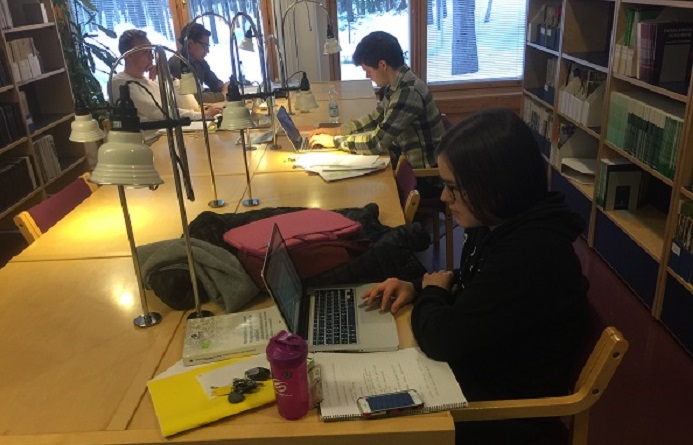Finland no longer highly educated compared to EU, OECD countries
Published : 03 May 2024, 22:00
Updated : 03 May 2024, 22:04
There has been a decline in achieved learning outcomes in Finland in proportion to the general level in the OECD countries since 2009, and continuing between 2018 and 2022, according to Bildung Review published by the Ministry of Education and Culture on Friday.
The review compiled statistical and other information on the administrative branch of the Ministry, its development and situation in international comparison also found that that in international comparison, the areas in Finland are no longer among highly educated areas when compared with the European or OECD (Organization for Economic Cooperation and Development) countries.
The difference between Uusimaa and the capital regions of the Nordic, European and other developed countries is increasing, said the ministry in a press release referring to the study.
The number of Finnish postgraduate students in higher education institutions has declined by approximately 30 per cent (6,200 students) between 2005 and 2020.
As a result of the decline in researcher training and the increase in the proportion of foreign students, the number of Finnish postgraduate students and scientific postgraduate degrees completed by Finns was at the lowest level since the 1990s at the beginning of the 2020s.
The field of education structure is undergoing a transformation. The field of technology has been by far the largest field of education, but its relative position has now weakened and the number of working-age people with a qualification or degree in the field is on the decline. The fields of health and wellbeing are growing fast, and the fields of business and administration more slowly.
The discipline structure of universities has changed fairly slowly in the past 40 years. The field of engineering sciences has grown considerably and has become clearly the largest field. The fields with relatively the highest growth also include social sciences. The proportion of the fields of medicine, humanities and education in academic staff has been declining for a long time.
Literature and international theatre and cinema are the fields of culture that the Bildung Review particularly focuses on. The number of titles in published literature has decreased in the 21st century. The proportion of fiction in published books has increased, and so has the proportion of history and biographies. In addition to general works, the strongest decrease has been seen in literature in the fields of politics, the economy, engineering sciences, law and public administration.
The themes for 2024 are regionality, life cycle and the fields of education and culture. The objective of the annually published review is to create an overall picture of the extensive administrative branch as a whole.
There is strong regional variation in participation in educational and cultural services and educational attainment and the use of educational and cultural services are differentiating regionally and at the level of smaller areas.
The differences in education vary within Finland. Educational attainment in Uusimaa is significantly higher than in the rest of the country. The proportion of the adult population that has completed only basic education (primary and lower upper secondary education) is about 25 per cent in the whole country and the differences between regions are reasonably small.
Regional differences in the proportion of population with a vocational education (upper secondary and specialist vocational level) are significantly greater than the differences between those with only basic education. The proportion of persons with a vocational education varies from 34 per cent in Southwest Finland to 45 per cent in Kainuu. The proportion in Uusimaa is 25 per cent.
The proportion of persons who have completed a higher education degree in the population aged over 15 years varies from approximately 40 per cent in Uusimaa to 26 per cent in Kainuu.
There is strong regional variation in participation in educational and cultural services. Educational attainment and the use of educational and cultural services are differentiating regionally and at the level of smaller areas.
The differences in education vary within Finland. Educational attainment in Uusimaa is significantly higher than in the rest of the country. The proportion of the adult population that has completed only basic education (primary and lower upper secondary education) is about 25 per cent in the whole country and the differences between regions are reasonably small.
Regional differences in the proportion of population with a vocational education (upper secondary and specialist vocational level) are significantly greater than the differences between those with only basic education. The proportion of persons with a vocational education varies from 34 per cent in Southwest Finland to 45 per cent in Kainuu. The proportion in Uusimaa is 25 per cent.
The proportion of persons who have completed a higher education degree in the population aged over 15 years varies from approximately 40 per cent in Uusimaa to 26 per cent in Kainuu.
There are differences linked with the regional distribution of the service provision in the cultural services used.
Cultural interests focus mostly on going to the cinema and to museums. The proportion of people who have visited a museum or an art exhibition at least once a month is notably large in Helsinki compared with the rest of Uusimaa and especially with the other areas in Finland.
Youth services concentrate strongly in municipalities with the largest number of young people.
In 2022, the total number of personnel in youth work was approximately 3,100 person-years in the whole country, of which about 40 per cent were located in eight municipalities (Helsinki, Oulu, Vantaa, Espoo, Jyväskylä, Turku, Lahti and Tampere).
The proportion of pupils participating in religious education according to the syllabus for the Evangelical Lutheran religion has declined rapidly from the 2010s and the share of ethics and Islam has increased.
This is because the proportion of pupils belonging to the Evangelical Lutheran Church is declining and the proportion of pupils belonging to other religious communities or non-religious pupils is increasing.


